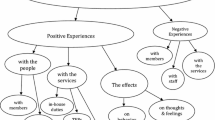Abstract
Children of incarcerated parents are five to six times more likely to go to prison than their peers (Johnston, 1995). Yet, there is a lacuna in the literature that examines the effectiveness of interventions for children with an incarcerated family member. The purpose of the present study is to describe a solution-focused, mutual aid group intervention and to examine the effects of the group on the self-esteem of elementary-age Hispanic children of incarcerated parents when compared to a no-treatment comparison group. Implications for social work practice and research with this vulnerable population are addressed.
Similar content being viewed by others

References
Berg, I. K., & de Shazer, S. (1991). Solution talk. In D. Sollee (Ed.), Constructing the future (pp. 15-29). Washington, DC: American Association for Marriage and Family Therapy.
Bjannes, A. (1995). Children and families of prison inmates: A challenge to the research and service communities. Paper presented at the 42nd Semi-annual Conference of the Association for Criminal Justice Research, California.
Cartledge, G., Lee, J. W., & Feng, H. (1995). Cultural diversity: Multicultural factors in teaching social skills. In G. Cartledge & J. F. Milburn (Eds.), Teaching social skills to children and youth: Innovative approaches (3rd ed.) (pp. 328-355). Boston, MA: Allyn and Bacon.
Child Welfare League of America [CWLA] (1996). Parents in prison: Children in crisis. Washington, DC: CWLA Press.
Cohen, J. (1977). Statistical power analysis for the behavioral sciences. New York: Academic Press.
Coopersmith, S. (1967). The antecedents of self-esteem. San Francisco, CA: Freeman.
Corder, B., Whiteside, L., & Haizlip, T. (1981). A study of curative factors in group psychotherapy with adolescents. International Journal of Group Psychotherapy, 31, 345-354.
de Shazer, S. (1985). Keys to solution in brief therapy. New York: Norton.
DiMascio, W. M. (1997). Seeking justice: Crime and punishment in America. New York, NY: The Edna McConnell Clark Foundation.
Gabel, S. (1992). Behavioral problems in sons of incarcerated or otherwise absent fathers: The issue of separation. Family Process, 31, 303-314.
Gamer, T., & Schrader, A. (1985). Children of incarcerated parents. In I. Stuart & I. At (Eds.), Problems and interventions. Children of separation and divorce: Management and treatment. New York: Van Nostrand Rheinhild.
Gitterman, A., & Shulman, L. (Eds.) (1994). Mutual aid groups, vulnerable populations, and the life cycle (2nd ed.). New York: Columbia University Press.
Hare, G. R. (1980). Self-perception and academic achievement: Variations in a desegregated setting. American Journal of Psychiatry, 137, 683-689.
Hoag, M. J., & Burlingame, G. M. (1997). Evaluating the effectiveness of child and adolescent group treatment: A meta-analytic review. Journal of Clinical Child Psychology, 26(3), 234-246.
Johnston, D. (1995). Effects of parental incarceration. In K. Gabel & D. Johnston (Eds.), Children of incarcerated parents (pp. 59-88). New York: Lexington Books.
Kahn, S. R. (1994). Children's therapy groups: Case studies of prevention, reparation, and protection through children's play. Journal of Child and Adolescent Group Therapy, 4(1), 47-60.
Konopka, G. (1949). Therapeutic group work with children. Minneapolis, MN: University of Minnesota Press.
McWhirter, A., McWhirter, B., McWhirter, E., & McWhirter, J. (1998). At risk youth: A comprehensive response. Pacific Grove, CA: Brooks Cole.
Pablon, E. (1998). Providing culturally competent juvenile justice services to the Latino community. Professional development: The International Journal of Continuing Social Work Education, 1(1), 38-46.
Rosenberg, M. (1965). Society and the adolescent self-image. Princeton, NJ: Princeton University Press.
Rubin, A., & Babbie, E. (1997). Research methods for social work (3rd ed.). Pacific Grove, CA: Brooks/Cole.
Sack, W. H., Seidler, T., & Thomas, S. (1976). Children of imprisoned parents: A psychosocial exploration. American Journal of Orthopsychiatry, 46(4), 618-628.
Schwartz, W. (1961). The social worker in the group. In New perspectives on services to groups: Theory, organization, and practice (pp. 7-34). New York: National Association of Social Workers.
Selekman, M. D. (1997). Solution-focused therapy with children: Harnessing family strengths for systemic change. New York: The Guilford Press.
Shulman, L. (1992). The skills of helping: Individuals, families, and groups (3rd ed.). Itasca, IL: F. E. Peacock.
Siegel, S., & Castellan, N. J. (1988). Nonparametric statistics for the behavioral sciences (2nd ed.). New York: McGraw-Hill, Inc.
Springer, D. W., Pomeroy, E. C., & Johnson, T. (1999). A group intervention for children of incarcerated parents: Initial blunders and subsequent solutions. Groupwork, 11(1), 54-70.
Tutty, L. M., & Wagar, J. (1994). The evolution of a group for young children who have witnessed family violence. Social Work with Groups, 17(1/2), 89-104.
Vastola, J., Nierenberg, A., & Graham, E. H. (1994). The lost and found group: Group work with bereaved children. In A. Gitterman & L. Shulman (Eds.), Mutual aid groups, vulnerable populations, and the life cycle (2nd ed.) (pp. 81-96). New York: Columbia University Press.
Yalom, I. D. (1995). The theory and practice of group psychotherapy (4th ed.). New York: Basic Books.
Author information
Authors and Affiliations
Rights and permissions
About this article
Cite this article
Springer, D.W., Lynch, C. & Rubin, A. Effects of a Solution-Focused Mutual Aid Group for Hispanic Children of Incarcerated Parents. Child and Adolescent Social Work Journal 17, 431–442 (2000). https://doi.org/10.1023/A:1026479727159
Issue Date:
DOI: https://doi.org/10.1023/A:1026479727159



